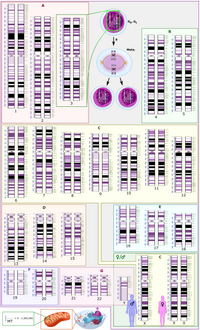
Photo from wikipedia
© BMJ Publishing Group Limited 2022. No commercial reuse. See rights and permissions. Published by BMJ. DESCRIPTION With the advancement of costefficient nextgeneration sequencing technology already impacting clinical medicine, one… Click to show full abstract
© BMJ Publishing Group Limited 2022. No commercial reuse. See rights and permissions. Published by BMJ. DESCRIPTION With the advancement of costefficient nextgeneration sequencing technology already impacting clinical medicine, one may be led to believe that clinical phenotyping should become an afterthought in diagnosing genetic conditions. Here, we exemplify why this is not the case. We report a child, born at 38 weeks to nonconsanguineous parents, who presented to the paediatric team at 4 months of age with poor feeding, developmental delay, dysmorphic features and failure to thrive. Facial features included hypertelorism, bilateral ptosis, downslanting palpebral fissures, a higharched palate, long fingers and toes and macrocephaly. A clinical diagnosis of a RASopathy was suspected, and the patient’s DNA was analysed for pathogenic variants in 15 genes within the RasMAPK pathway (a targeted gene panel)—uptodate available testing at the time. A maternally inherited variant in NF1 c.3218_3232dup22 was identified and reported as a variant of uncertain significance. This variant was also present in his mother (father was not available for testing). Finding this variant was unexpected, but as it was maternally inherited and as his mother displayed a similar phenotype, a provisional diagnosis of NoonanNF1 (Neurofibromatosis type 1)related disorder was made. In view of the NF1 variant of unknown significance and unclear fit with clinical phenotype, he went on to have duo whole exome sequencing which did not identify any relevant pathogenic variants. At 7 years of age, he was rereferred to Genetics clinic from Neurosurgery due to a new development of cervical vertebral abnormalities. Advancements in genomic testing meant that both the patient and mother were able to undergo further agnostic duo exome sequence analysis. The patient was then found to be heterozygous for a SKI missense variant (c.59C>T, p.Thr20Met Class 4 variant)—this was not present in the mother. A patient previously diagnosed with ShprintzenGoldberg syndrome (SGS) had a similar variant. Our patient’s phenotype had evolved over time, making a diagnosis of SGS more obvious when finally detected on exome sequencing. This report illustrates the importance of clinical phenotyping and repeated clinical review of patients to aid diagnosis. Detailed clinical phenotyping enabled a diagnosis to be made in this patient even when initial exome sequencing was deemed negative. Investigative genetic technology will continue to advance, yet this makes clinical phenotyping even more crucial as a diagnosis must fit with both the genetic and phenotypic picture. Further advancements in promising technology will progress genomic medicine. 3 Yet research into improving phenotyping algorithms may be just as important in coming to a diagnosis. It has been suggested that this area may be potentially overlooked and that current algorithms may lack accuracy when it comes to clinical phenotyping. Due to the importance of clinical phenotyping, further research into phenotyping algorithms should be undertaken; genome sequencing is here to stay, but clinical phenotyping remains an important diagnostic tool.
Journal Title: BMJ Case Reports
Year Published: 2022
Link to full text (if available)
Share on Social Media: Sign Up to like & get
recommendations!